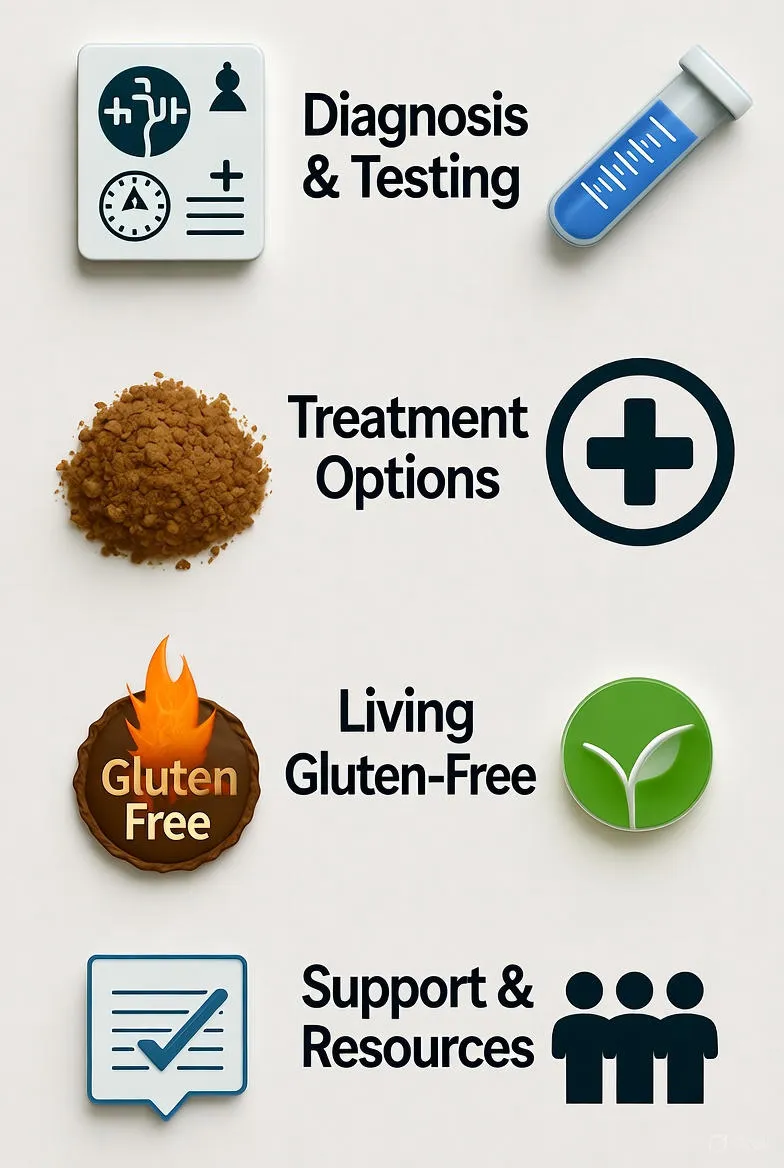Unveiling the Impact: How Gluten Influences Gut Health and Microbiome Balance
Discover the complex relationship between gluten and gut health. From celiac disease to microbiome disruptions, learn the science, symptoms, and dietary considerations for optimal digestive wellness.

Introduction
The human gut is a bustling ecosystem, home to trillions of microorganisms that play a pivotal role in digestion, immune function, and even mental well-being. At the heart of this delicate balance lies the food we consume, and few ingredients spark as much debate as gluten. Found in wheat, barley, and rye, gluten is a protein that gives dough its elasticity. But for many, it's more than just a baking staple—it's a potential disruptor of gut harmony. This article delves into the science of how gluten affects gut health, exploring everything from autoimmune reactions to subtle microbiome shifts. Whether you're experiencing unexplained bloating or simply curious about dietary trends, understanding gluten's role can empower you to make informed choices for your digestive system.
What is Gluten and Why Does It Matter?
Gluten is a composite of storage proteins called gliadin and glutenin, rich in glutamine and proline amino acids that make them resistant to complete breakdown by human digestive enzymes. When ingested, these proteins are partially hydrolyzed into peptides that interact with the intestinal lining. For most people, this process is uneventful, allowing nutrients to be absorbed efficiently. However, in susceptible individuals, these peptides can trigger a cascade of immune responses, leading to inflammation and barrier dysfunction.
The gut's mucosal barrier, fortified by tight junctions between epithelial cells, acts as a gatekeeper, permitting beneficial substances while blocking pathogens. Key players like zonulin—a protein that regulates these junctions—can be dysregulated by gluten-derived peptides. When zonulin levels spike, the barrier becomes 'leaky,' allowing unwanted particles to enter the bloodstream and provoke systemic inflammation. This leaky gut phenomenon is a common thread in gluten-related issues, underscoring why gluten's impact extends beyond the stomach to overall health.
Gluten and Celiac Disease: The Autoimmune Onslaught
Celiac disease (CD) represents the most severe manifestation of gluten intolerance, affecting approximately 1% of the global population, though many cases remain undiagnosed. In genetically predisposed individuals—those carrying HLA-DQ2 or HLA-DQ8 genes—gluten peptides mimic harmful invaders, igniting an autoimmune response. T-cells in the lamina propria attack the intestinal villi, the finger-like projections responsible for nutrient absorption, causing atrophy and malabsorption.
Symptoms of untreated CD are diverse and debilitating: chronic diarrhea, abdominal pain, fatigue, weight loss, and even neurological issues like headaches or peripheral neuropathy. Beyond the gut, it heightens risks for osteoporosis, infertility, and certain cancers due to nutrient deficiencies. Histologically, small intestine biopsies reveal flattened villi and increased intraepithelial lymphocytes, hallmarks confirmed by serologic tests for anti-tissue transglutaminase antibodies.
The mechanism is intricate: Gliadin peptides bind to CXCR3 receptors on immune cells, releasing zonulin and compromising tight junctions. This increased permeability allows more gluten fragments to cross, amplifying the immune assault. Inflammatory cytokines such as IL-6, IL-13, interferon-gamma, and TNF-α surge, perpetuating damage. Studies show that in CD patients, gluten exposure elevates these markers significantly higher than in healthy controls, highlighting the exaggerated response.
- Common CD Symptoms: Bloating, gas, and irregular bowel movements
- Extraintestinal Signs: Dermatitis herpetiformis (itchy skin rash), anemia from iron malabsorption
- Long-Term Risks: Increased incidence of autoimmune thyroiditis and type 1 diabetes
The only effective treatment is a lifelong strict gluten-free diet (GFD), limiting intake to less than 20 parts per million. Compliance restores villous architecture within months, alleviating symptoms and reducing inflammation.
Non-Celiac Gluten Sensitivity: Symptoms Without the Autoimmunity
Not everyone with gut woes has celiac disease, yet up to 6-10% of people report adverse reactions to gluten without the characteristic antibodies or villous damage. This condition, dubbed non-celiac gluten sensitivity (NCGS), manifests with gastrointestinal discomfort—bloating, abdominal pain, diarrhea—and extras like fatigue, joint pain, or 'brain fog.' Diagnosis is by exclusion, relying on symptom resolution upon gluten elimination and recurrence upon reintroduction.
Unlike CD, NCGS doesn't involve adaptive immunity but rather innate responses. Gluten peptides and associated wheat components, such as amylase-trypsin inhibitors (ATIs), activate toll-like receptors (TLRs) on immune cells, spurring cytokine release like IL-8 and IL-15. ATIs, non-gluten proteins in wheat, are potent activators of TLR4, mimicking bacterial lipopolysaccharides and driving low-grade inflammation. Some symptoms may also stem from fermentable oligosaccharides (FODMAPs) in wheat, complicating attribution solely to gluten.
Research indicates NCGS patients exhibit baseline microbiome alterations, with higher levels of Actinobacillus and Ruminococcaceae. Brief gluten challenges don't drastically shift the microbiota, but a GFD often improves symptoms, suggesting a tolerance threshold. Prevalence is hard to pinpoint, but surveys suggest it's more common in those with irritable bowel syndrome (IBS), where up to 30% benefit from gluten restriction.
Gluten's Profound Influence on the Gut Microbiome
The gut microbiome, comprising over 1,000 species of bacteria, fungi, and viruses, ferments undigested fibers into short-chain fatty acids (SCFAs) like butyrate, which nourish colonocytes and modulate immunity. In celiac disease, pre-diagnosis dysbiosis is evident: an overabundance of Proteobacteria (e.g., Pseudomonas), Bacteroides, and Prevotella, coupled with depletion of protective Firmicutes, Bifidobacteria, and Lactobacilli. These shifts impair gluten peptide degradation—Lactobacillus species normally break down gliadin, reducing immunogenicity—and exacerbate barrier permeability.
Upon adopting a GFD, the microbiome partially rebounds, resembling healthy profiles more closely, though biodiversity may dip. A 2022 study found that periodic gluten exposure in treated CD patients doesn't significantly alter the microbiome, implying resilience post-treatment. However, in NCGS, GFD effects on microbiota are mixed; some report normalization, others persistent imbalances.
Beyond disorders, gluten influences healthy guts. A landmark 2018 Danish trial with 60 adults compared high-gluten (18g/day) and low-gluten (2g/day) diets over eight weeks. The low-gluten arm, substituting wheat/rye with other fibers, reduced Bifidobacterium species, Dorea longicatena, and butyrate-producers like Anaerostipes hadrus and Eubacterium hallii. Functionally, carbohydrate metabolism pathways waned, and fermentation shifted, lowering breath hydrogen and bloating. Participants lost 0.8kg more on low-gluten, with elevated appetite-suppressing peptide YY, hinting at metabolic perks—but at the cost of beneficial taxa.
Recent Revelations: Low-Gluten Diets May Backfire
Fast-forward to 2025, and emerging research paints a cautionary tale. A French randomized trial with 40 healthy adults on a 16-week low-gluten diet (from ~15g to minimal) revealed progressive dysbiosis. Alpha-diversity plummeted, with declines in Verrucomicrobiota and Actinomycetota phyla. Key depletions included Bifidobacterium (confirmed via qPCR), Akkermansia muciniphila—a mucin-degrader linked to metabolic health—and fiber-fermenters like Ruminococcus species. Conversely, Enterobacteriaceae surged tenfold, and gluten-degrading Clostridia waned.
Metabolically, ethanol levels tripled, potentially fueling inflammation and metabolic syndrome, while isobutyrate dropped. Though total SCFAs held steady thanks to redundant butyrate-producers like Roseburia, the shifts suggest long-term risks: reduced resilience to pathogens, impaired polyphenol metabolism from lower fiber diversity, and heightened glycemic loads from gluten-free alternatives like rice and maize. Lead researcher Dr. Emilie Delmas noted, 'While short-term comfort may lure, sustained low-gluten without need could erode microbial guardians, inviting imbalance.'
These findings challenge the gluten-free boom, emphasizing that for non-sensitive individuals, habitual gluten supports a robust microbiome. The 2018 study's fiber-substitution caveat holds: changes may owe more to grain swaps than gluten itself, but the pattern of Bifidobacterium loss recurs, warranting personalized approaches.
Gluten's Ripple Effects on Inflammatory Conditions
Gluten's tentacles reach beyond isolated sensitivities to broader gastrointestinal disorders. In inflammatory bowel disease (IBD)—encompassing Crohn's disease and ulcerative colitis—celiac patients face a 13-fold higher risk. Gluten exacerbates flares via ATIs, which recruit monocytes and amplify Th1/Th17 responses. A survey of 1,647 IBD patients found 65.5% symptom relief on GFD, with 38.3% fewer flares.
For functional GI disorders like IBS, gluten restriction aids 71% of diarrhea-predominant cases, curbing bloating and urgency. Mechanisms involve zonulin-mediated permeability, allowing bacterial translocation and low-grade endotoxemia. Even in wheat allergy—an IgE-mediated hypersensitivity—gut symptoms like nausea arise acutely, though microbiome data is sparse.
- IBD Link: Gluten peptides mimic bacterial motifs, sustaining chronic inflammation
- IBS Overlap: 20-30% of patients test negative for CD but respond to GFD
- Therapeutic Nuances: Probiotics with gluten-degrading strains (e.g., Rothia mucilaginosa) show promise in adjunct therapy
Navigating a Gluten-Conscious Diet: Pros, Cons, and Practical Tips
Is gluten the villain for everyone? Hardly. For the gluten-tolerant majority, it provides essential B vitamins, fiber, and prebiotics from whole grains, fostering microbial diversity. Yet, if symptoms persist, elimination trials under medical guidance are wise—perhaps via a low-FODMAP gluten-free phase to isolate triggers.
Pros of GFD: Rapid symptom relief, microbiome partial restoration in sensitives. Cons: Nutrient gaps (fiber, folate), higher costs, and processed GF products laden with sugars. To thrive:
- Incorporate naturally GF grains like quinoa, oats (certified), and buckwheat
- Boost microbiome with fermented foods: yogurt, kimchi, sauerkraut
- Monitor via stool tests for dysbiosis markers like calprotectin
Consult a gastroenterologist or dietitian; self-diagnosis risks unnecessary restriction. Emerging therapies, like enzyme supplements (e.g., latiglutenase) to degrade gliadin, offer hope for accidental exposures.
Conclusion
Gluten's saga with gut health is nuanced: a harmless staple for most, a harbinger of havoc for the sensitive. From celiac's villous devastation to NCGS's subtle irritations, and microbiome modulations that swing both ways, the evidence urges moderation and awareness. Recent studies remind us that extremes—be it unchecked consumption or blanket avoidance—can tip the microbial scales. Prioritize whole foods, listen to your body, and let science guide your plate. A balanced gut isn't about demonizing gluten, but harmonizing with it—or without it—as your biology demands. Your digestive destiny awaits, one mindful meal at a time.


